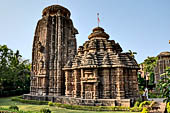| enter keyword to search: |
|
Images db
|
|
|
Articles db
|
|
|
|
|
|
|
|
|
One of the oldest Indian towns, Bhubaneswar is one of the few places in India which have archaeological remains from the earliest period down to the end of Hindu rule. The city still preserves a large number of the 7,000 or more temples constructed here, from the viii to the xiii century AD, under royal patronage, some finest examples of Orissan temples and of early style of Hindu architecture. It is generally believed that the old city of Bhubaneswar developed around the Lingaraja temple, erected to Lord Shiva as the Lord of the Three Worlds, Tribhuneshvara, thus the name Bhubaneswar (alternative spelling Bhubaneshwar Bhubaneshvara). This zone, a living heritage city, is characterized by the presence of more than a hundred standing temples in a various state of preservation, sacred stepped water tanks, traditional people and priests.
Bindu Sagar |

|
Many of the temples are built near and around the Bindu Sagar the large devotional tank dug in proximity of the Lingaraja. Once a year Lingaraj is brought here in the small temple in the centre of the lake Jaga Mandir for ritual bath. We liked to stay here at around sunset watching the bathing pilgrims and stray cows and bulls around the ghats nearby the dharamshala.

|
Lingaraja temple
|
The mighty Lingaraja temple (xi C.) dominates the surrounding landscape with its tower, the tallest in Bhubaneswar. The Lingaraj Mandir is very much a "living" shrine: Singh Dwaar, the small square in front of the main gateway, is throngs with pilgrims clutching flowers and bananas, bought at the colourful stalls nearby, to be offered as prashad to the deity.
Following anti-clockwise the temple enclosure around the NE corner in a large esplanade there is the chariot used during the yatra festivals. Close by there is the viewing platform, the only point where the temple can be seen by the non-hindu.
Chitrakarini Temple |

|
From the platform proceeding north (towards Vital Deul) on the left side of the street we noticed some interesting old temples that can be easily missed but worth while visiting. The Chitrakarini temple in a well maintained garden kept by the Archaeological Survey of India and three other temples clustered around the Papanashini Kund, standing side by side within the same enclosure on the bank of the Papanasini tank, Maitresvara (xi c) and Varunesvara, the third temple is a little further to the west. Soon we reached Vaital Deul (viii C.), dedicated to Chamunda the terrifying aspect of Durga, rare example in Orissa of the kakhara style, the temple boasts some very accomplished stonework. In the same precinct the contemporaneous Sisiresvara Temple. From here a short walk leads us to the west bank of Bindu Sagar recently converted in a well kept gardened area.

|
Parsurameswar Mandir
|
A second group of temples can be reached on foot from the east bank of Bindu-Sagar. On the bank of the tank there a number of other temples, the small withe washed Brahma Temple (xv C.) devoid of architectural and sculptural motifs. The Vaishnavite Ananta Vasudeva temple (A.D. 1278 ), famous for the cocked rice sold to the people as prasad (Holy Food). We continue our walk following a small lane departing east from the lake. Before reaching the Parsurameswar Mandir on the shore of a small kund we found the Kotitirthesvara Siva temple.
In the shade of a large banyan tree the Parsurameswar Mandir is a beautiful example of earliest Orissan architecture, well preserved in its pristine purity. Crossing a grassy field we quickly reached Mukteswar Temple set in a low-walled courtyard, with its excellent torana and sculptures the temple is a jewel of Orissan architecture. Between the Mukteswar and the road, the small Murich Kunda is believed to cure infertility.
Rajarani Mandir |

|
From Muktesvara with a short tuc-tuc ride on Tankapani Rd we reached the eastern group of temples. In a well maintained garden Rajarani Mandir, managed by the Archaeological Survey of India, is among the finest of Bhubaneshwar with its beautiful Dikpalas. From Rajrani, following Tankapani Rd you cross a canal, originally dug by king Kharavela in the first century BC, and reach Brahmesvara Mandir, inside its high enclosure walls the saffron pennant flying from the top of the deul indicates that the temple still houses a living deity.

|
Hirapur Chausathi yoginis Temple
|
Not far from Bhubaneswar, in the village of Hirapur on the ancient road that leads to Puri, the Chausathi yoginis (the sixty four yoginis) temple is one of the only four yoginis temples in India and surely it is the best preserved, with its beautiful yogini images carved from black chlorite.
Today Bhubaneswar is a Saivite town but in the remote past also Buddhism and Jainism religions found here home at one time or another, giving to the city its sacred character and its wealth on religious sculpture and architecture. In the periphery of the city are situated the famous Udaigiri and Khandagiri caves, the site of the famous Rani Gumpha (ii C. BC ) and, at Dhauli, the remarkably well preserved King Ashoka edict carved in stone after the Kalinga War of the 261 BC with on top of the rock a sculpted elephant, symbol of Lord Buddha.
Udaigiri and Khandagiri caves |

|
| |
|
|
 |
|
|



